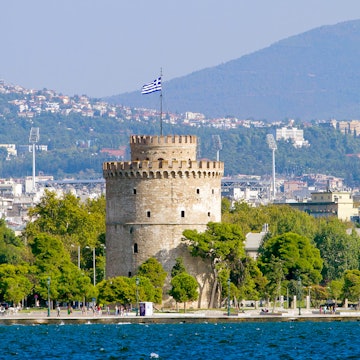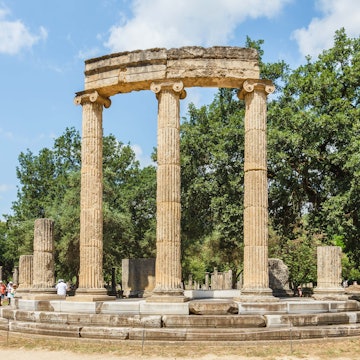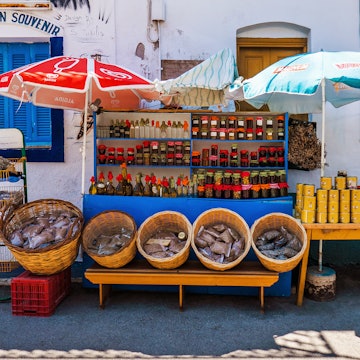

Tourists dining on a terrace at a restaurant in Zakynthos. LauraVl/Shutterstock
Greeks love eating out, sharing impossibly big meals with family and friends in a drawn-out, convivial parade of dishes. Whether you're eating seafood at a waterfront table or sampling contemporary Greek cuisine under the floodlit Acropolis, dining out in Greece is never just about what you eat, but the whole sensory experience.
Take a cue from the locals and go straight to the source, heading to seaside fishing hamlets for fresh fish or mountain villages for local meat. Seek out tavernas that produce their own vegetables, wine and oil, where the fried potatoes are hand-cut and recipes are passed down through generations. Regional variations are a delight to explore – no two meals will be the same – and these are some hints for how to get started. The ultimate guide to eating traditional Greek food in Greece.
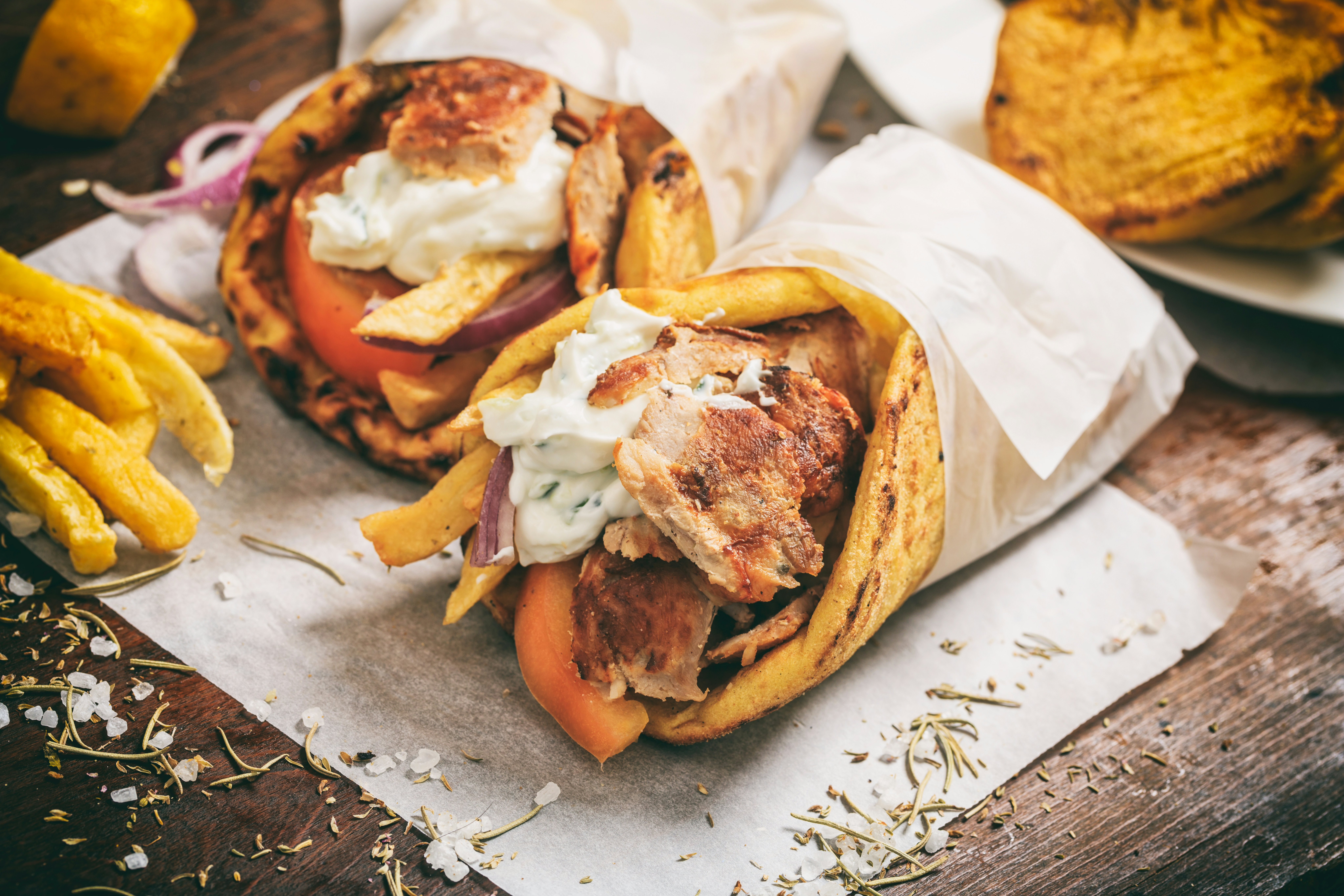
Devour Greece’s favorite street food, souvlaki
Greece’s adored fast food, souvlaki, comes as either gyros (meat cooked on a vertical rotisserie) or skewered meat versions wrapped in soft pita bread, with tomato, onion, and lashings of tzatziki. They often throw in some potato chips, to give it a little extra heft. Usually, you’ll be choosing between pork or chicken, but once in a while, you might encounter lamb. If you’d like to eat it right there and then, ask for it “sto heri” – in hand.
Where to try it: Kosta's in Athens is an authentic street food experience. If you’re in Thessaloniki, go to Derlicatesen all Souvlaki. As a rule of thumb, great souvlaki can be found in psistarias (grill houses).
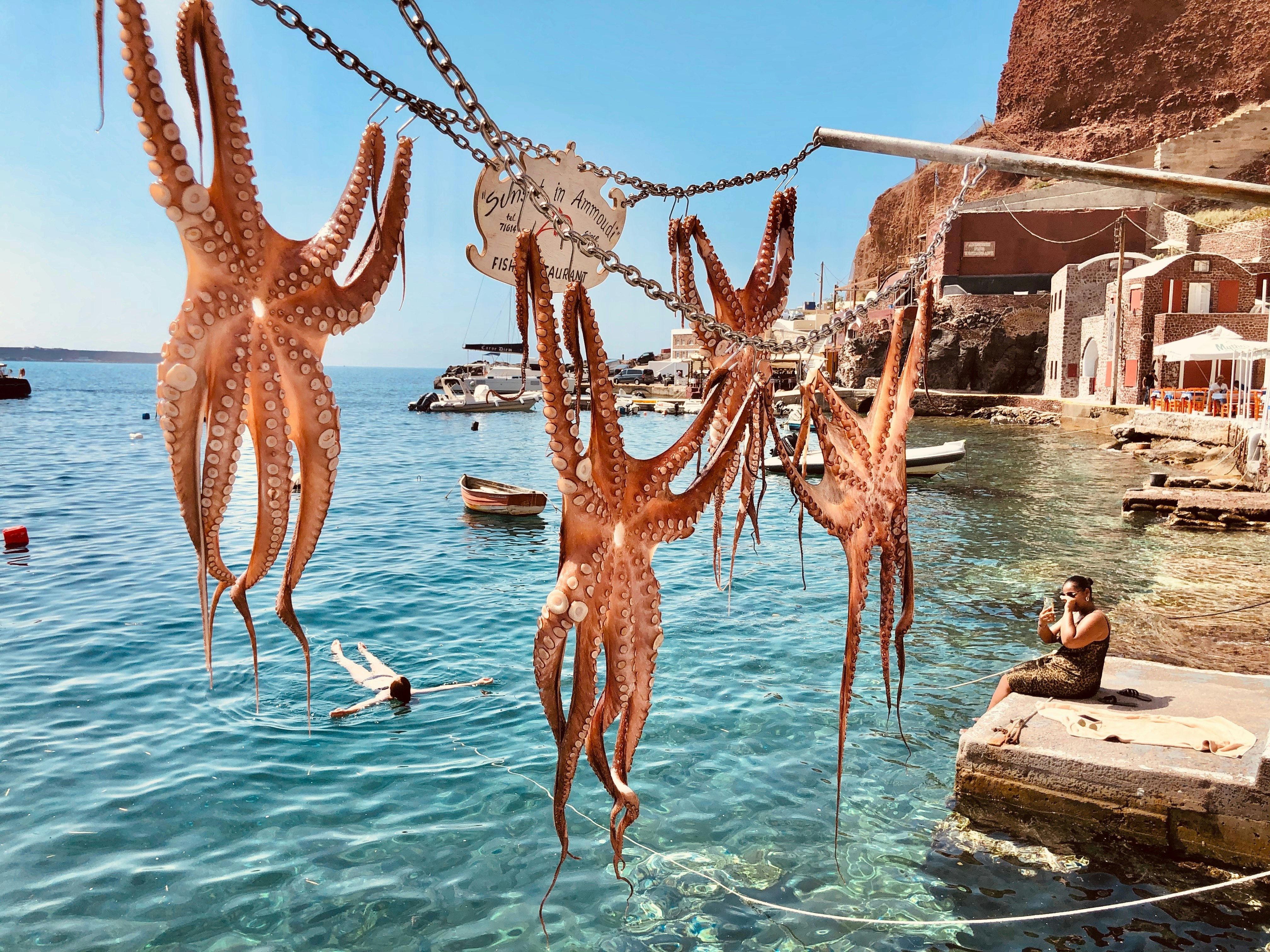
Savor succulent fish and seafood
What’s a trip to Greece without seafood, in all its variations and glory? Fish is often grilled whole and drizzled with ladolemono (lemon and oil dressing). Smaller fish such as barbounia (red mullet) or maridha (whitebait) are lightly fried and you can eat the whitebait or anchovies whole, or delicately nibble the meat off the bones. Octopus is grilled, marinated or stewed in wine sauce.
Other popular seafood dishes in Greece include soupies (cuttlefish) or calamari stuffed with cheese and herbs, and psarosoupa (fish soup) – which comes in as many variations as there are kitchens. The best way to avoid imports is to seek out tavernas run by local fishing families, then always pick out your fish and ask what it weighs if you want to know the price (sometimes staggering). Best of all, eat it on the shore.
Where to try it: Find upscale seafood at Four Seasons Hydra on Hydra. For a Michelin-starred experience, go to Varoulko, which has locations in Athens and Santorini. Tavernas in seaside towns on the Greek islands, like Captain Pipinos on Antiparos, are perfect for trying fish dishes without spending a fortune.
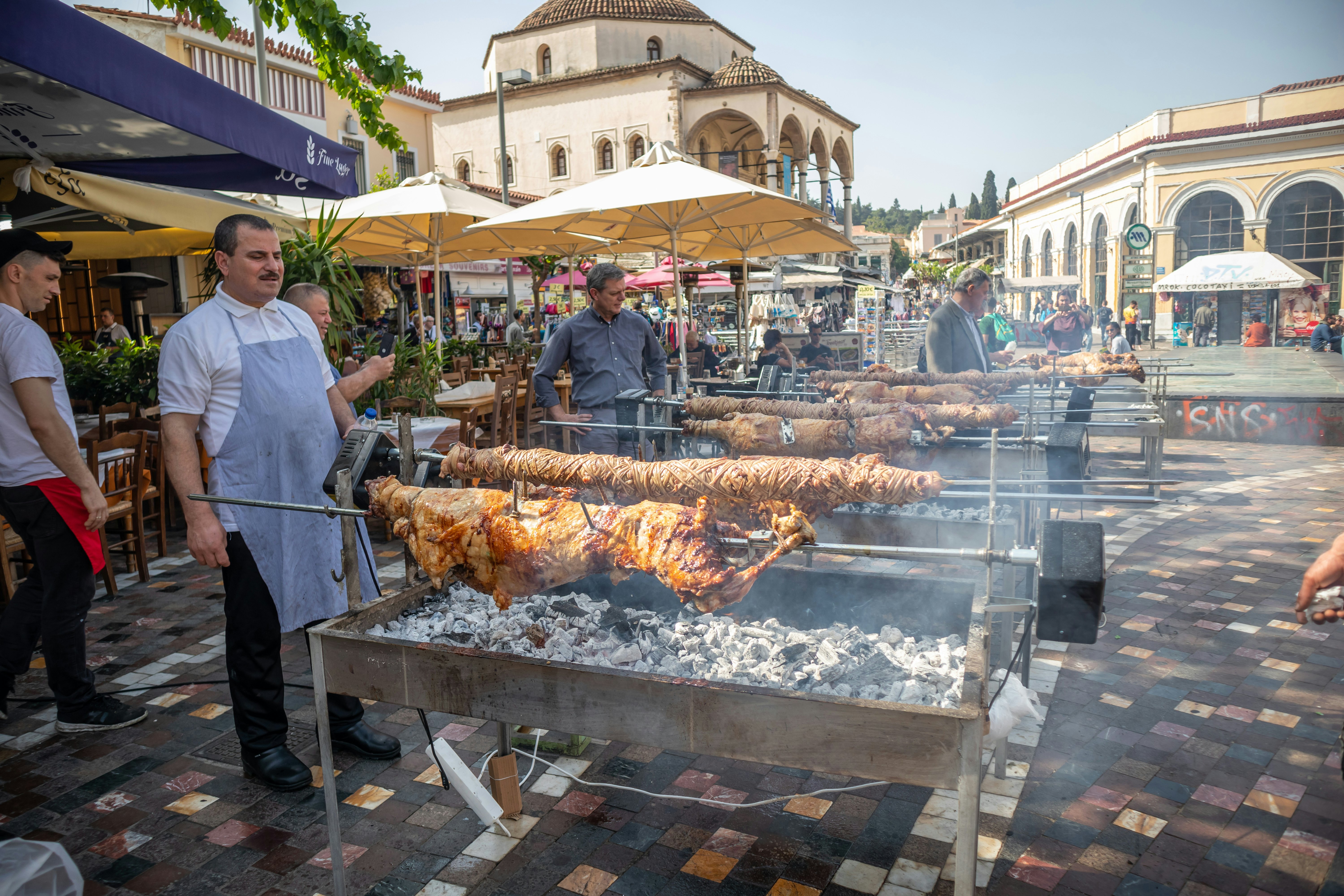
Grab some great grilled meat
Greeks are masterful with grilled and spit-roasted meats. In addition to souvlaki, enjoy païdakia (lamb cutlets) and brizoles (pork chops), or fresh fish and calamari. From Tsiknopempti – a holiday when grilled meat is eaten before Lent – to the Easter celebrations where lamb is either grilled or spit-roasted to break the fast, or even at a basic meal in grill restaurants, be sure to pick the skewers or chops up with your hands. No dainty silverware needed.
Sides are often simple: potatoes, vegetables and dips. The most common meats are beef, lamb, chicken and pork, but there are some goat dishes, too, like slow-cooked kapamas, a roast baby goat dish from Rhodes.
Where to try it: For affordable prices and local flavors, choose To Steki Tou Ilia in Athens. Check out Rozalia for mouthwatering grilled meats served in a garden setting. Discover more options in our guide detailing what to eat and drink in Athens. Sea vistas and popular Greek grilled meat dishes are available at charming Vassilis in Paros.

Pretend you’re at Gramma’s house, with mayirefta
Home-style, one-pot, baked or casserole dishes, mayirefta are a staple of taverna life and therefore in the pantheon of typical Greek dishes. Stroll back into the restaurant to peruse what’s on offer. Prepared early, these dishes are left to cool to enhance the flavors and a good glance will whet your appetite as you choose.
Well-known mayirefta include yemista (vegetables stuffed with rice and herbs), lemonato (red meat or chicken with lemon and oregano), stifadho (sweet, stewed meat with tomato and onion) and moussaka, which is often considered Greece’s most famous dish (eggplant, minced meat, potatoes and cheese). But there are endless varieties, some vegetarian or vegan, others hearty meat, often served over rice, orzo or pasta.
Where to try it: Beachfront Mira on Paros is ideal for sunset watching and mayirefta tasting. Mirsini village-set Teréza in the heart of Tinos is a fantastic choice for home-cooked fare.
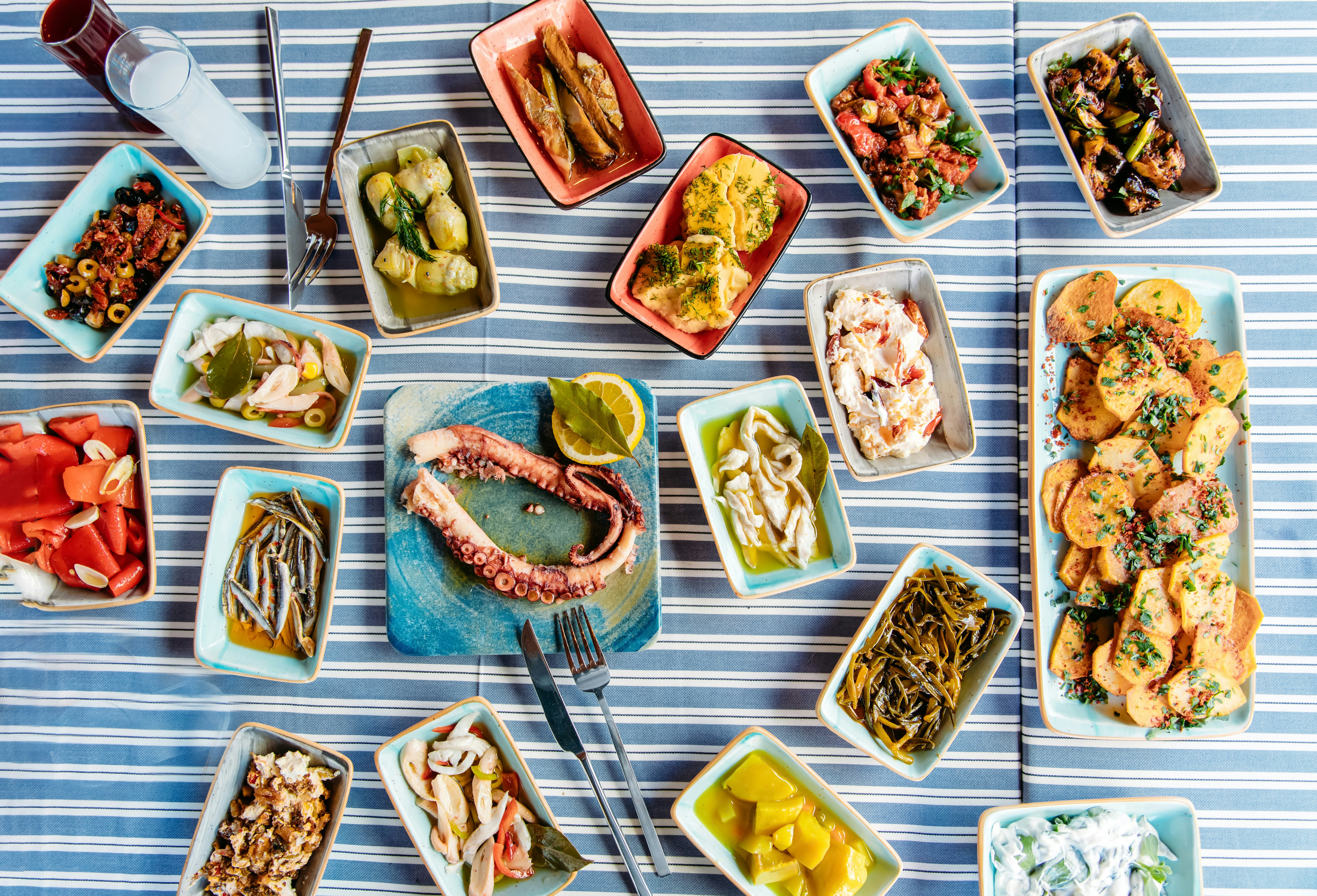
Delight in a mezedhes smorgasbord
These small dishes are usually shared and can serve as a full meal or simply appetizers to dishes yet to come. Classics include tzatziki (yogurt, cucumber and garlic), melitzanosalata (aubergine dip), taramasalata (fish roe dip), fava (split-pea puree with lemon juice), and saganaki (fried cheese). Also watch for keftedes (Greek meatballs), loukaniko (pork sausage), grilled gavros (white anchovies), and dolmades (rice wrapped in marinated grape leaves). Classic pairing? Ouzo.
Where to try it: In Athens, Tzitzikas & Mermingas is heaven for meze lovers. Ouzeri Halaris is perfect for a waterfront setting and modern seafood mezedhes offerings, like tuna tartar with avocado salad and white fish ceviche with pink pepper and ginger. Other great island restaurants include To Maridaki in Hania, Crete, and Ston Pyrgo on Amorgos.

Crunch into crispy pies
Bakeries make endless variations of tyropita (cheese pie), spanakopita (spinach pie), and other pies, usually based on regional ingredients. In Crete, there is the luscious custard-filled bougatsa, as well as a seemingly endless variety of cheese pies with different herb and flavor accents, from honey to anise. Cinnamon-topped bougatsa is among the favorite breakfast dishes in Greece (especially in Thessaloniki), usually enjoyed with a cup of coffee.
Where to try it: In northern Greece, find bougatsa in Thessaloniki at bakeries like Bougatsa Giannis. On Crete, head to Bougatsa Iordanis in Hania. Ariston serves top-notch pies in Athens.

Zap your palate with ouzo and other spirits
Ouzo – Greece's famous liquor – has come to embody a way of eating and socializing, enjoyed with meze during lazy, extended summer afternoons. Sipped slowly and ritually to cleanse the palate between dishes, ouzo is usually served in small bottles or karafakia (carafes) with a bowl of ice cubes to dilute it (turning it a cloudy white).
Ouzo is made from distilled grapes with residuals from fruit, grains and potatoes, and flavored with spices – primarily aniseed – giving it that licorice flavor. The best ouzo is produced on Lesvos.
Tsipouro is a distilled spirit, similar to grappa, that is made only in Greece. It's created using the leftover must from pressing wine and is usually quaffed as an aperitif. Tsikoudia, also known as raki, is essentially the Cretan version of tsipouro.
If these options are too harsh a shot of alcohol for your tastes, you may well prefer the sweet liqueur mastiha, made with mastic resin grown on Chios. It's an excellent digestif.
Where to try it: Discover ouzo production methods and buy a few bottles at The World of Ouzo and Varvagianni Ouzo Museum on Lesvos. Mastiha Shop in Athens sells all things mastic resin.

Sip on award-winning Greek wine
The local wine industry benefits from some age-old indigenous varietals and centuries of traditions with origins in Ancient Greece. The contemporary generation of winemakers is producing award-winning wines from the country’s premier wine regions, including Nemea in the Peloponnese, the vineyards of Santorini, the Iraklio Wine Country on Crete and Naoussa in the north.
White varieties include moschofilero, assyrtiko, athiri, roditis, robola, and savatiano. The most popular Greek reds include xinomavro, agiorgitiko and kotsifali. House or barrel wine varies dramatically in quality (white is the safer bet) and is ordered by the kilo/carafe or glass.
Greek dessert wines include excellent muscats from Samos, Limnos and Rhodes, Santorini's vinsanto, mavrodafni wine (often used in cooking) and Monemvasia's malmsey.
Retsina, white wine flavored with the resin of pine trees, became popular in the 1960s and retains a largely folkloric significance with foreigners. It's something of an acquired taste but some winemakers make a modern version. It’s popular in Thessaloniki (where the main brand, Malamatina, is made) and it goes great with salty meze and seafood.
Where to try it: For an upscale wine tasting, check out Estate Argyros Winery and Gavalas Winery, both in Santorini. Thymiopoulos Vineyards gives you an immersion into the rich wine-making traditions of Paros.
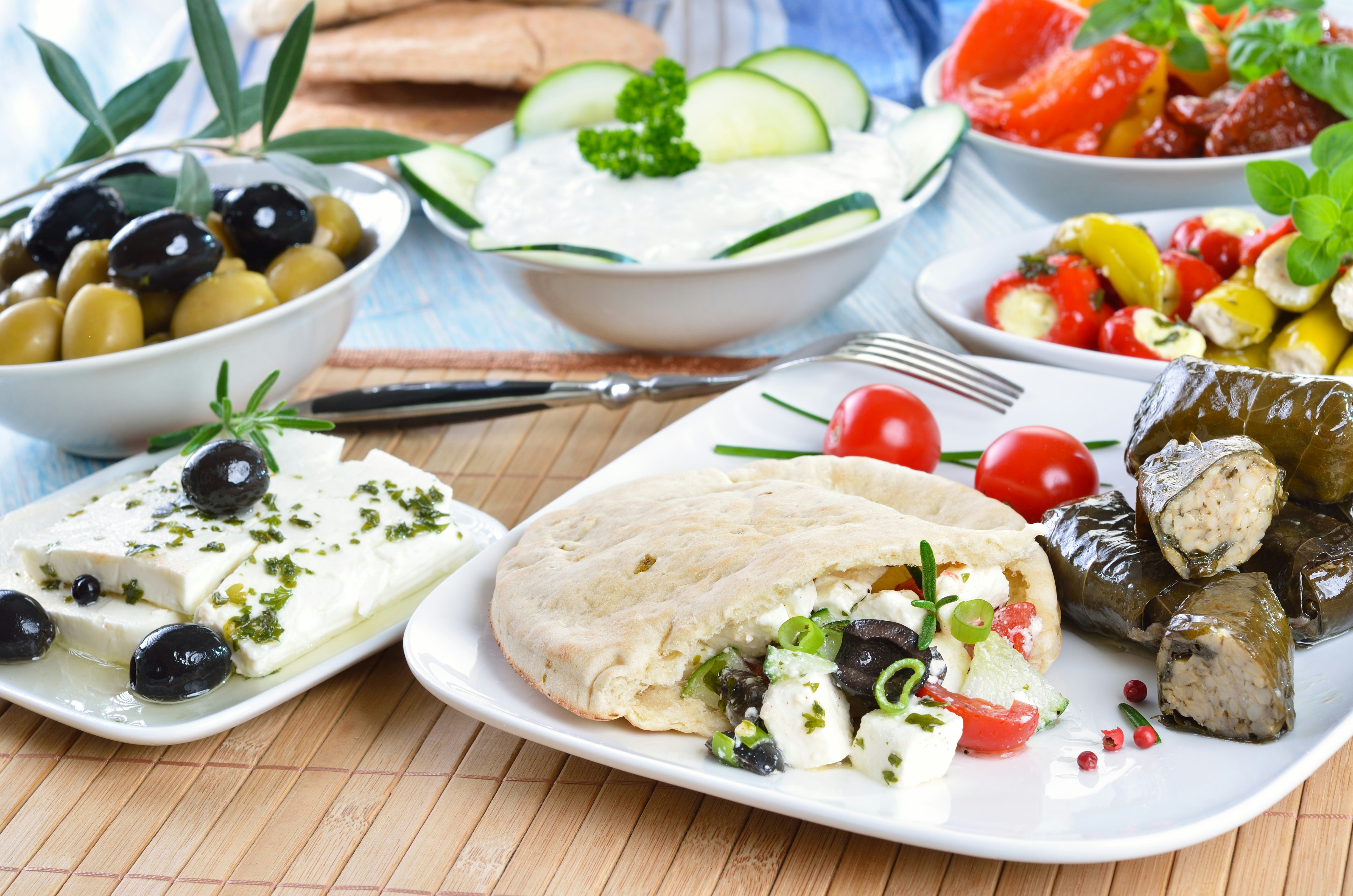
Enjoy fresh-baked pita and more
Whether you’re in a big mainland city or an island town, the aroma of freshly baked bread is dominant in the morning. Yeast-leavened pocketless pita flatbread is well-known Greek fare, but it's the fillings and regional variations that will delight your tastebuds. Be sure to sample tiropsomo (feta cheese-filled flatbread), koulouri (a Greek take on a rounded sesame seed-covered bagel) and lagana (a traditional Clean Monday flatbread topped with olive oil).
Where to try it: Look for yellow street carts in Thessaloniki for the best koulouri. In Athens, Pnyka and Dimou are among the most beloved traditional local bakeries.
Cool down with a frappé
The cold, frothy frappé was invented in 1957 by a Nescafé vendor from Thessaloniki, when he mixed instant coffee, cold water, sugar and milk. Today, frappés are a beloved Greek beverage, preferably enjoyed on a terrace overlooking the Aegean Sea. A delightfully refreshing option on a hot summer's day.
Where to try it: You can find frappés in almost every cafe and coffee shop around Greece. Melina, with its views of the Plaka neighborhood, is a top choice in Athens. Cafe Nikis 35 in Thessaloniki is perfect for a waterfront frappé break.
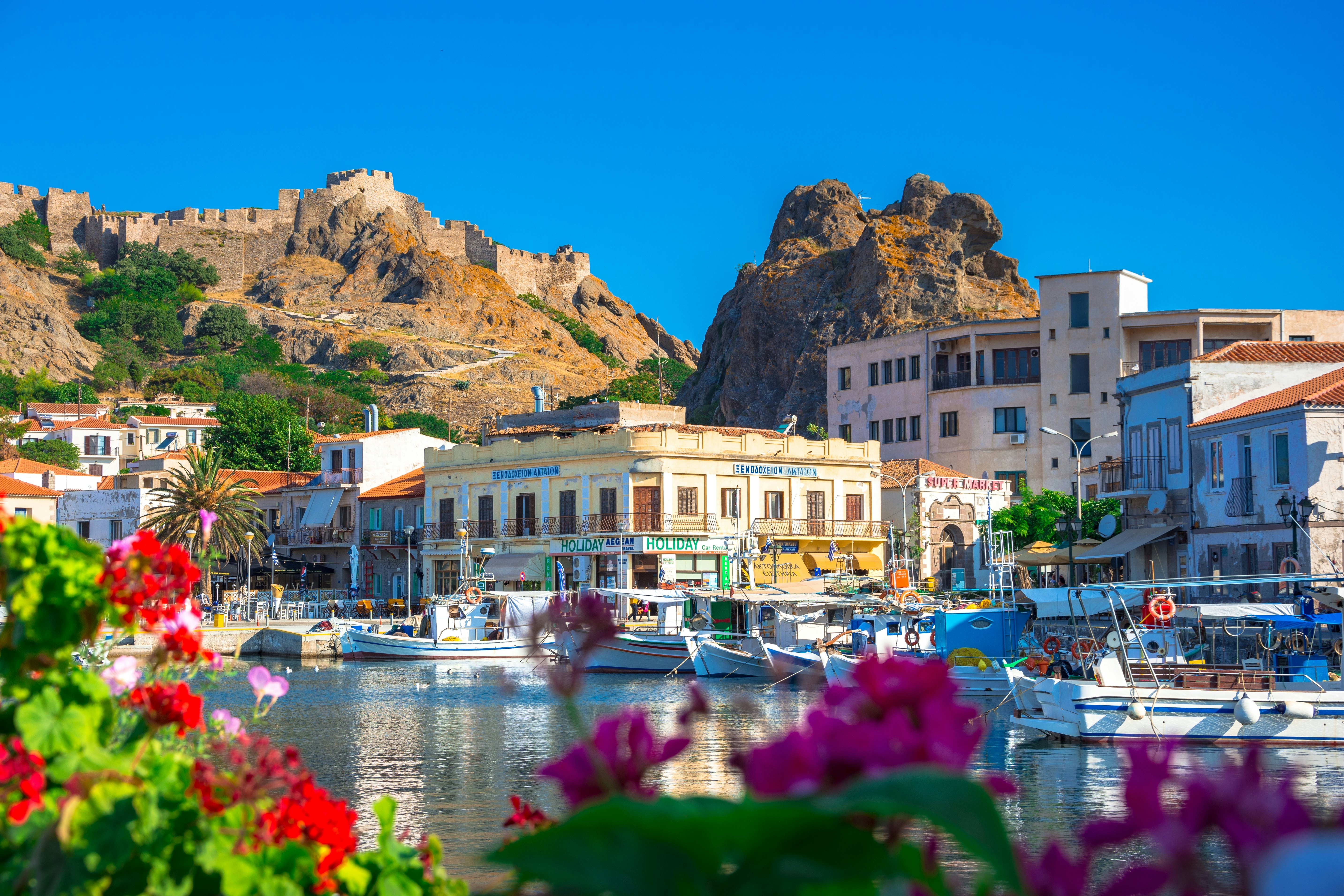
Discover how Greeks do pasta
While Italy may tout global pasta domination, Greece quietly makes some of the finest pasta dishes in the Mediterranean, and the recipes change as you travel around the country.
The Limnos food scene is known for flomaria, a type of pasta often served with rooster and tomato sauce. Egg-free seashell-shaped gogges macaroni are a Peloponnese specialty. When in Crete, the whole-wheat skioufichta topped with local anthotyros cheese is a must.
Where to try it: For a cheerful family restaurant and the best flomaria in Limnos, check out Opos Palia. High-end MANIMANI is a wonderful introduction to Peloponnesian cuisine in the heart of Athens.

Indulge in street food sweet treats
If you try one Greek dessert, make it loukoumades. A street food staple, these crisp deep-fried balls are served topped with honey and cinnamon. The donuts pair really well with Greek kaimaki ice cream topped with mastic (a resin variety from Chios Island).
Where to try it: Lukumades is a late-night institution in the center of Athens and Cremino is a must-visit for kaimaki.
Vegetarians and vegans
Vegetarians are well catered for in Greece since vegetables feature prominently – a legacy of lean times and the Orthodox faith's fasting traditions. The more traditional a restaurant you go to, the more vegetable options you get, because they follow more of these fasting rules. If you come during Lent, it’s a vegan bonanza at these places.
Look for popular vegetable dishes such as fasolakia yiahni (braised green beans), bamies (okra), revythia (stewed chickpeas), briam (oven-baked vegetable casserole) and vine-leaf dolmadhes. Of the nutritious horta (wild greens), vlita (amaranth) is the sweetest, but other common varieties include wild radish, dandelion, stinging nettle and sorrel. Ensure you confirm with the waitstaff that the vegetables have not been prepared in a meat-based broth.
For those that eat dairy, Greece's regions produce many different types of cheese, most using goat's and sheep's milk, with infinite variations in taste. Apart from feta, local cheeses include graviera (a nutty, mild Gruyere-like sheep's-milk cheese), kasseri (similar to provolone), myzithra (ricotta-like whey cheese) and manouri (creamy soft cheese from the north). Not found elsewhere in Greece, Santorini’s chlorotyri is a soft, creamy goat's cheese that gives a local twist to the traditional Greek salad or else turns up in dolmadhes in the island’s restaurants.
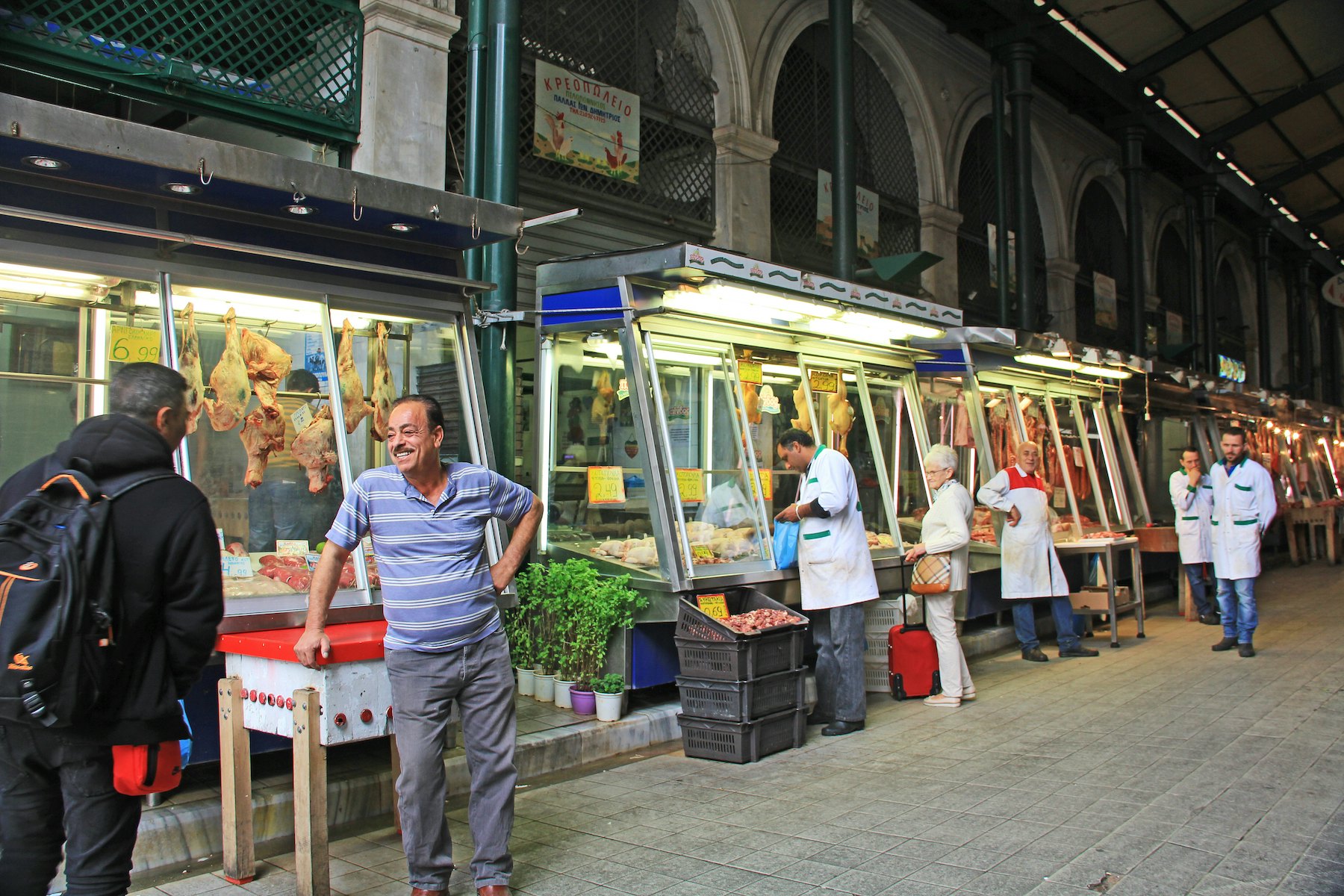
A year in food
Spring
Artichokes and other fresh vegetables abound while cheesemaking kicks into gear. Easter is celebrated with tsoureki (brioche-style bread, sometimes flavored with cherry kernels and mastic) and dyed-red hard-boiled eggs.
Summer
Watermelon, cherries and other fruit jam pack the markets. In August, Skala Kaloni on Lesvos celebrates its sardine festival, while in the Peloponnese you can attend Leonidio's Aubergine Festival.
Autumn
Nuts and figs are harvested and raki (Cretan firewater) is distilled. Aegina's pistachio industry celebrates Fistiki Fest in mid-September. Raki or tsikoudia festivals are held in Voukolies and Cretan villages in November when olive oil is produced.
Winter
Olive harvest peaks. Honey cookies are eaten at Christmas to end fasting. On New Year's Day, the golden-glazed cake vasilopita is shared.








